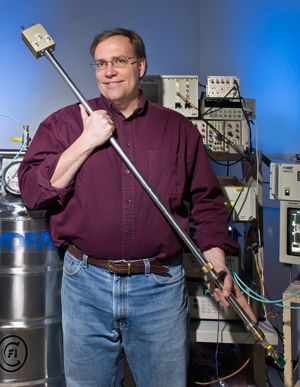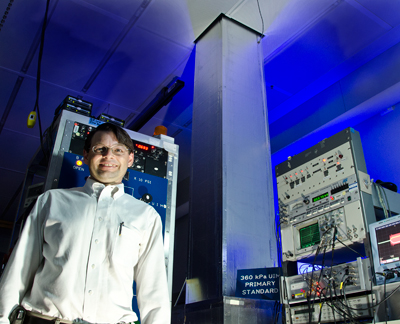In recent days, four scientists in the Physical Measurement Laboratory (PML) of the National Institute of Standards and Technology (NIST) have been recognized by scientific organizations for outstanding work.

Samuel Benz, of PML's Optoelectronics and Photonics Division, has received the 2016 Joseph F. Keithley Award in Instrumentation and Measurement from the Institute of Electrical and Electronics Engineers (IEEE) for outstanding contributions in electrical measurements.
His citation reads: "For creating and disseminating quantum-based superconducting voltage standards that form the basis for worldwide precision voltage measurements." (Click here for background on Benz and the voltage standard.)
According to the organization, "for nearly a century, the IEEE Awards Program has paid tribute to technical professionals whose exceptional achievements and outstanding contributions have made a lasting impact on technology, society, and the engineering profession."

Gretchen Campbell of PML's Quantum Measurement Division has won the 2015 Young Scientist Prize of the International Union of Pure and Applied Physics' section on Atomic, Molecular and Optical Physics. Campbell is honored for "outstanding contributions in toroidal Bose-Einstein condensates and its application to 'atomtronic' circuits." (For information on Campbell and the research, click here.)
The prize will be awarded during the 29th International Conference on Photonic, Electronic and Atomic Collisions (ICPEAC) to be held on 22-28 July 2015 at the Congress Centre El Greco in Toledo, Spain. The Prize includes a certificate, a medal, a € 1,000 award and an invited presentation at ICPEAC.

Hendricks was cited for "exceptional contributions to vacuum science and for developing new and revolutionary vacuum standards and methods through promoting excellence in vacuum measurement as well as being a mentor to early career scientists and engineers."
The AVS, a technical society formerly known as the American Vacuum Society, has 4500 members worldwide. Hendricks, a member of AVS Mid Atlantic Chapter, serves as chair of IUVSTA (International Union for Vacuum Science, Technique and Applications), which represents nearly 15,000 physicists, chemists, materials scientists, engineers, and technologists who are linked through their common use of vacuum.
For information about Hendricks' current project, click here.
Glenn Solomon of the Quantum Measurement Division has received a Fulbright fellowship to conduct joint research with the University of Innsbruck. The visit will be highly supportive of his ongoing experimental research program at NIST and will allow him to strengthen his relationship with PML's colleagues in Innsbruck.
NIST has a long-standing program in quantum information science that includes creating coherence in quantum dots — a type of nanostructure — that can lead to everything from single photon sources to the core components of quantum computer — a so-called quantum bit or qubit. These types of efforts have been at the core of NIST's leadership in quantum information science and have been the basis of the four Nobel Prizes that NIST has won over the past 20 years.
The research groups at the University of Innsbruck have been collaborators and competitors with NIST and PML for many years. Solomon will be working most directly with the research team of Professor Gregor Weihs looking at ways to better exploit quantum dots in microcavities for use as sources of individual photons and entangled photon pairs and as sources for photons with different spatial and temporal characteristics that could be exploited in new quantum-based precision measurements.
For information about Solomon's research on quantum dots and other semiconductor nanostructures, click here.

